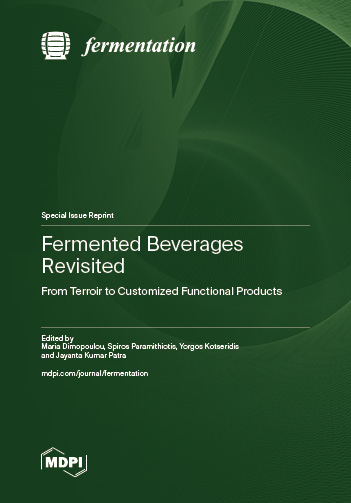Fermented Beverages Revisited: From Terroir to Customized Functional Products
A special issue of Fermentation (ISSN 2311-5637). This special issue belongs to the section "Fermentation for Food and Beverages".
Deadline for manuscript submissions: closed (15 October 2023) | Viewed by 20103
Special Issue Editors
Interests: food microbiology; sparkling wine; yeast; yeast–yeast interactions; wine; mixed culture; fermentation conditions; sensory; food microbiology; alcohol reduction; native yeast
Special Issues, Collections and Topics in MDPI journals
Interests: food microbiology; food biotechnology; molecular microbiology
Special Issues, Collections and Topics in MDPI journals
Interests: wine aroma; wine polyphenolics; polysaccharides; yeasts and bacteria; sensory analysis; winemaking; natural wines; wine composition
Special Issues, Collections and Topics in MDPI journals
Interests: medicinal plants; nanobiotechnology; fermented foods; functional foods
Special Issues, Collections and Topics in MDPI journals
Special Issue Information
Dear Colleagues,
A wide variety of fruits and grains are employed as substrates for fermentation, resulting in a range of beverages, some of which are known to provide unique characteristics of certain geographical areas. Terroir is a term mostly affiliated with wine, but can be expanded to all products subjected to a similar fermentation process. Terroir is associated with agricultural practices, micro-climatic conditions, soil composition, cultivar and the microecosystem that drives fermentation. The same parameters may also affect the functional characteristics of the products, such as their antioxidant, anti-inflammatory and anticarcinogenic activity, as well as protect against neurodegenerative and cardiovascular diseases. On the other hand, a series of metabolites, such as biogenic amines and ochratoxins, may exert adverse effects on human health. The micro-ecosystem implicated in the fermentation process may include yeasts, as well as lactic and acetic acid bacteria, and may affect these functions via metabolic activities. The diversity of the implicated microbial species is quite extended, and accompanied by a remarkable variability in metabolic capacity.
The conceptual, methodological and technological advances of recent years have enabled the rapid characterization of micro-communities. In addition, genetic data treated with bioinformatic tools have allowed the in silico assessment of the metabolic capacity of the strains under study and the prediction of metabolic activities. This information is valuable, as it facilitates the selection of starter cultures with properties tailored to specific technological or nutritional needs.
The aim of this Special Issue is to collect articles that update the current knowledge on the factors that affect the terroir of fermented beverages and define their functional properties.
Dr. Maria Dimopoulou
Dr. Spiros Paramithiotis
Prof. Dr. Yorgos Kotseridis
Dr. Jayanta Kumar Patra
Guest Editors
Manuscript Submission Information
Manuscripts should be submitted online at www.mdpi.com by registering and logging in to this website. Once you are registered, click here to go to the submission form. Manuscripts can be submitted until the deadline. All submissions that pass pre-check are peer-reviewed. Accepted papers will be published continuously in the journal (as soon as accepted) and will be listed together on the special issue website. Research articles, review articles as well as short communications are invited. For planned papers, a title and short abstract (about 100 words) can be sent to the Editorial Office for announcement on this website.
Submitted manuscripts should not have been published previously, nor be under consideration for publication elsewhere (except conference proceedings papers). All manuscripts are thoroughly refereed through a single-blind peer-review process. A guide for authors and other relevant information for submission of manuscripts is available on the Instructions for Authors page. Fermentation is an international peer-reviewed open access monthly journal published by MDPI.
Please visit the Instructions for Authors page before submitting a manuscript. The Article Processing Charge (APC) for publication in this open access journal is 2600 CHF (Swiss Francs). Submitted papers should be well formatted and use good English. Authors may use MDPI's English editing service prior to publication or during author revisions.
Keywords
- fermented beverages
- alcoholic fermentation
- lactic acid fermentation
- acetic acid fermentation
- functional metabolites







